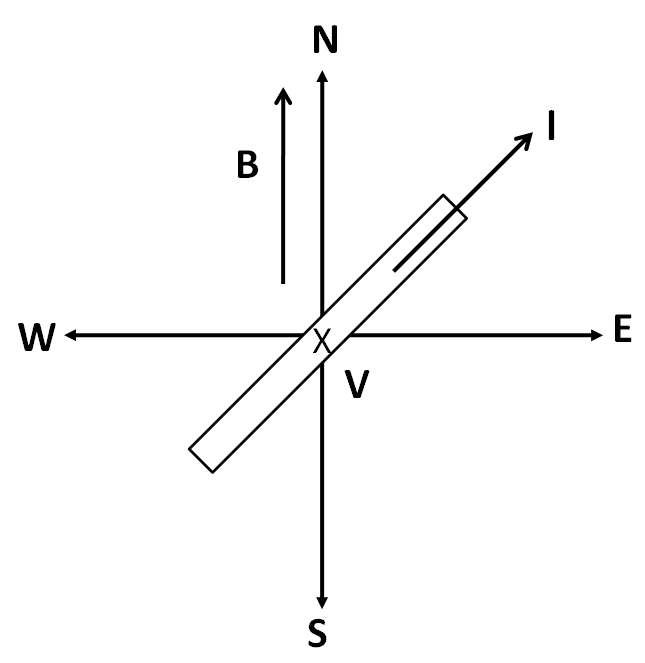Answer
401.7k+ views
Hint:
To solve this question, we need to use the formula for the motional emf induced. We have to analyse the situation of the conductor, and write each of the variables in terms of the vector representation. Then, substituting these vectors in the emf equation will give the required emf induced in the rod.
Formula used: The formula used to solve this question is
$e = \left( {\vec v \times \vec B} \right) \cdot \vec l$
Where $e$ is the emf induced in a conductor $\vec v$ is the velocity of the conductor, $\vec B$ is the magnetic field, and $\vec l$ is the length of the rod.
Complete step by step answer:
The situation is shown in the below diagram.

We know that the emf induced in a conductor due to its motion in a magnetic field is given by
$e = \left( {\vec v \times \vec B} \right) \cdot \vec l$
According to the question, $\vec v = - 5.0\overset{\lower0.5em\hbox{$\smash{\scriptscriptstyle\frown}$}}{k} {\text{ }}m/s$\[\vec B = 0.3 \times {10^{ - 4}}{\text{ }}\overset{\lower0.5em\hbox{$\smash{\scriptscriptstyle\frown}$}}{j} Wb/{m^2}\], and $\vec l = 10\left( {\frac{{\overset{\lower0.5em\hbox{$\smash{\scriptscriptstyle\frown}$}}{i} + \overset{\lower0.5em\hbox{$\smash{\scriptscriptstyle\frown}$}}{j} }}{{\sqrt 2 }}} \right)m$
(the directions of each of the vectors are shown in the figure)
Substituting these in the emf equation, we get
\[e = ( - 5.0\overset{\lower0.5em\hbox{$\smash{\scriptscriptstyle\frown}$}}{k} \times 0.3 \times {10^{ - 4}}{\text{ }}\overset{\lower0.5em\hbox{$\smash{\scriptscriptstyle\frown}$}}{j} ) \cdot \frac{{10}}{{\sqrt 2 }}\left( {\overset{\lower0.5em\hbox{$\smash{\scriptscriptstyle\frown}$}}{i} + \overset{\lower0.5em\hbox{$\smash{\scriptscriptstyle\frown}$}}{j} } \right)\]
We know that \[\overset{\lower0.5em\hbox{$\smash{\scriptscriptstyle\frown}$}}{k} \times {\text{ }}\overset{\lower0.5em\hbox{$\smash{\scriptscriptstyle\frown}$}}{j} = - \overset{\lower0.5em\hbox{$\smash{\scriptscriptstyle\frown}$}}{i} \]
\[\therefore e = 1.5 \times {10^{ - 4}} \times \frac{{10}}{{\sqrt 2 }}i \cdot \left( {\overset{\lower0.5em\hbox{$\smash{\scriptscriptstyle\frown}$}}{i} + \overset{\lower0.5em\hbox{$\smash{\scriptscriptstyle\frown}$}}{j} } \right)\]
$e = 1.1 \times {10^{ - 3}}{\text{V}}$
Therefore, the emf induced in the rod is equal to $1.1 \times {10^{ - 3}}{\text{V}}$.
Note:
It is always preferred to write the emf equation in terms of the vectors, as there is a high chance of committing mistakes in calculating the emf. Only the components of the length, the velocity of the conductor and the magnetic field, which are mutually perpendicular are multiplied together to get the emf induced.
To solve this question, we need to use the formula for the motional emf induced. We have to analyse the situation of the conductor, and write each of the variables in terms of the vector representation. Then, substituting these vectors in the emf equation will give the required emf induced in the rod.
Formula used: The formula used to solve this question is
$e = \left( {\vec v \times \vec B} \right) \cdot \vec l$
Where $e$ is the emf induced in a conductor $\vec v$ is the velocity of the conductor, $\vec B$ is the magnetic field, and $\vec l$ is the length of the rod.
Complete step by step answer:
The situation is shown in the below diagram.

We know that the emf induced in a conductor due to its motion in a magnetic field is given by
$e = \left( {\vec v \times \vec B} \right) \cdot \vec l$
According to the question, $\vec v = - 5.0\overset{\lower0.5em\hbox{$\smash{\scriptscriptstyle\frown}$}}{k} {\text{ }}m/s$\[\vec B = 0.3 \times {10^{ - 4}}{\text{ }}\overset{\lower0.5em\hbox{$\smash{\scriptscriptstyle\frown}$}}{j} Wb/{m^2}\], and $\vec l = 10\left( {\frac{{\overset{\lower0.5em\hbox{$\smash{\scriptscriptstyle\frown}$}}{i} + \overset{\lower0.5em\hbox{$\smash{\scriptscriptstyle\frown}$}}{j} }}{{\sqrt 2 }}} \right)m$
(the directions of each of the vectors are shown in the figure)
Substituting these in the emf equation, we get
\[e = ( - 5.0\overset{\lower0.5em\hbox{$\smash{\scriptscriptstyle\frown}$}}{k} \times 0.3 \times {10^{ - 4}}{\text{ }}\overset{\lower0.5em\hbox{$\smash{\scriptscriptstyle\frown}$}}{j} ) \cdot \frac{{10}}{{\sqrt 2 }}\left( {\overset{\lower0.5em\hbox{$\smash{\scriptscriptstyle\frown}$}}{i} + \overset{\lower0.5em\hbox{$\smash{\scriptscriptstyle\frown}$}}{j} } \right)\]
We know that \[\overset{\lower0.5em\hbox{$\smash{\scriptscriptstyle\frown}$}}{k} \times {\text{ }}\overset{\lower0.5em\hbox{$\smash{\scriptscriptstyle\frown}$}}{j} = - \overset{\lower0.5em\hbox{$\smash{\scriptscriptstyle\frown}$}}{i} \]
\[\therefore e = 1.5 \times {10^{ - 4}} \times \frac{{10}}{{\sqrt 2 }}i \cdot \left( {\overset{\lower0.5em\hbox{$\smash{\scriptscriptstyle\frown}$}}{i} + \overset{\lower0.5em\hbox{$\smash{\scriptscriptstyle\frown}$}}{j} } \right)\]
$e = 1.1 \times {10^{ - 3}}{\text{V}}$
Therefore, the emf induced in the rod is equal to $1.1 \times {10^{ - 3}}{\text{V}}$.
Note:
It is always preferred to write the emf equation in terms of the vectors, as there is a high chance of committing mistakes in calculating the emf. Only the components of the length, the velocity of the conductor and the magnetic field, which are mutually perpendicular are multiplied together to get the emf induced.
Recently Updated Pages
Seldane 02 phenol penicillin G Quinine Phenacetin Morphine class 11 chemistry CBSE

What do you see when pentahydrated copper sulfate crystals class 11 chemistry CBSE

What do you see when penta hydrated coppersulfate crystals class 11 chemistry CBSE

What do you see when concentrated nitric acid is added class 11 chemistry CBSE

Seema visited a Natural Gas Compressing Unit and found class 11 chemistry CBSE

Seema likes sugar apples which is a multipurpose an class 11 chemistry CBSE

Trending doubts
Which are the Top 10 Largest Countries of the World?

Difference Between Plant Cell and Animal Cell

Give 10 examples for herbs , shrubs , climbers , creepers

Fill the blanks with the suitable prepositions 1 The class 9 english CBSE

Difference between Prokaryotic cell and Eukaryotic class 11 biology CBSE

Write a letter to the principal requesting him to grant class 10 english CBSE

Change the following sentences into negative and interrogative class 10 english CBSE

Name 10 Living and Non living things class 9 biology CBSE

List some examples of Rabi and Kharif crops class 8 biology CBSE



